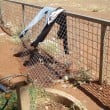B2.2 Drying clothes and bedding
Some houses do not have a place to dry clothes, bedding or towels. Drying in sunlight is preferable as the ultraviolet light can sterilise clothes and bedding and is also cost-free, unlike an electric clothes dryer that will use a large amount of energy.
Survey data indicates that 76% of houses have a clothesline and an adequate place for clothes drying. The clothesline could dry clothes in tropical areas during rain, and allowed sun to dry the clothes to reduce dust-mites. There was a drying area adequate for the family size and safe and protected from the street.
Data show over 80% of houses had some defined yard area (and 62% of those houses had secure fences and gates) to help accommodate a clothes drying area.
At the time of survey, fine and sunny weather conditions at 74% of the houses favoured outdoor air-drying. Air-drying costs nothing and takes advantage of sunlight’s ultra violet light to further sterilise clothes.
Whilst 90% of houses surveyed had at least one verandah, 53% of houses had a verandah on more than one side of the house. This would allow one verandah to be used as a general living area and still allow a covered place for drying clothes on another of the house’s verandahs.
Design and Specification
Ensure
- B2.2.1.
there is an outdoor clothes drying area that is easily accessible from the house
- B2.2.2.
that in areas with high rainfall, clothes lines are located in covered, ventilated areas
- B2.2.3.
where clothes lines are in yard areas, a slip resistant concrete path or paving to, and around, the clothes line is made to prevent ground erosion and improve access to the clothes line
- B2.2.4.
that in flats or apartments there is an secure outside area for tenants to dry clothes and bedding
Consider
- installing robust clothes lines around the edge of the house or in the yard where it is accessible from the laundry and gets sunlight and breezes, but is not in full view from the street
- locating the clothes line in a private, screened area
- in areas with high rainfall, locating a second clothes line in a covered, ventilated areas such as a verandah, and providing clear roof sheeting over part of this area to help with drying
- using a fixed clothes line rather than a rotary or folding clothes line to avoid failure of moving parts
- providing lighting to the drying area and any access pathway
- designing the path to provide access for people using a wheelchair or mobility frame
- installing a lower level clothes line, or a line that can be lowered, for use by people with disabilities.
Real world examples of Solutions
- B2.2.1.
Quality control
- the clothes linehas been designed, located and installed where specified

- SKETCH DESIGN
COMPLETED DESIGN & SPECIFICATION
DURING CONSTRUCTION
AT HANDOVER
FINAL COMPLETION
- SKETCH DESIGN
- the clothes line is securely fixed into the ground or to a wall

- DURING CONSTRUCTION
AT HANDOVER
FINAL COMPLETION
- DURING CONSTRUCTION
- the paths to and around the clothes line are accessible

- SKETCH DESIGN
COMPLETED DESIGN & SPECIFICATION
DURING CONSTRUCTION
AT HANDOVER
FINAL COMPLETION
- SKETCH DESIGN
- the clothes lines are tensioned.

- DURING CONSTRUCTION
AT HANDOVER
FINAL COMPLETION
TRADE TEST
- DURING CONSTRUCTION
- the clothes linehas been designed, located and installed where specified
Maintenance
As part of cyclical maintenance:
- check that clothes lines are functioning and replace or repair main support structure

- Local Maintenance Team
- 12 Months
- tighten loose clothes lines and replace rusted or broken lines

- Local Maintenance Team
- 12 Months
- repair or clean any path to the clothes line, to avoid slip or trip hazards

- Local Maintenance Team
- 12 Months
- check that clothes lines are functioning and replace or repair main support structure
Standard And References
Pholeros, P 1991, AP Design Guide, Building for Health on the Anangu Pitjantjatjara Lands, Nganampa Health Council Inc., Alice Springs, p. 35.
BASIX: Clothes drying lines - https://basix.nsw.gov.au/iframe/energy-help/other-energy-uses/clothes-drying.html

